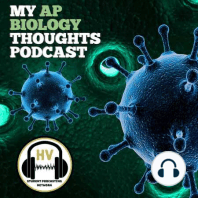6 min listen
Trophic Levels and Energy Flow
ratings:
Length:
4 minutes
Released:
Feb 15, 2021
Format:
Podcast episode
Description
My AP Biology ThoughtsUnit 8 Episode #23Welcome to My AP Biology Thoughts podcast, my name is Alex and I am your host for episode 23 called Trophic levels and energy flow.. Today we will be discussing these ideas and their importance to ecology.Segment 1: Introduction to Trophic LevelsTrophic levels are a means to categorize species in an ecosystem by their distance from the energy source. This separates species into different categories, such as producers, primary consumers, and secondary consumers, with some species being able to inhabit multiple categories depending on what they eat.Energy flow refers to how energy is transferred throughout an ecosystem. Energy generally flows in a linear direction, with energy going from low trophic levels to high trophic levels, with energy being lost to the environment as heat. So, what are examples of these ideas?Segment 2: Examples of Trophic LevelsA simple example of trophic levels would be an ecosystem of a plant, a worm, and a bird. In this ecosystem, the plant produces energy from the sun, the worm eats the leaves of the plant, and the bird eats the worm. This ecosystem would have the plant be the producer, as it gets its energy from the sun, with the worm being a primary consumer and the bird being a secondary consumer.Using this same ecosystem, we can also determine how energy flows through the system. The plant produces energy from the sun, and uses a portion of the energy to keep itself alive. This energy is lost to the environment as heat. When a worm eats the leaves, it gets only a portion of the energy that was made by the plant. The same thing happens to the bird: the worm uses some of the energy to live, and Segment 3: Digging Deeper into Trophic LevelsThese topics are extremely useful when explaining the number of organisms in each species. While producers are plentiful due to their ability to be self sufficient, we see that species which take up higher trophic levels exist in relatively small populations. This is due to the fact that only a fraction of energy is transferred between trophic levels, around only 10% per level. This makes food a huge limiting factor for many secondary and tertiary consumers, who have to constantly forage for relatively few calories. Although trophic levels and energy flow are relatively basic ideas, they are essential in understanding many interactions and population numbers of ecosystems.Thank you for listening to this episode of My AP Biology Thoughts. For more student-ran podcasts and digital content, make sure that you visit www.hvspn.com. See you next time!Music Credits:"Ice Flow" Kevin MacLeod (incompetech.com)Licensed under Creative Commons: By Attribution 4.0 License http://creativecommons.org/licenses/by/4.0/Subscribe to our PodcastApple...
Released:
Feb 15, 2021
Format:
Podcast episode
Titles in the series (100)
Endotherms and Ectotherms by My AP Biology Thoughts
